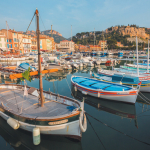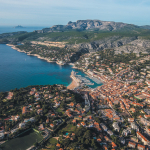From Marseille, the beautiful Route de Crêtes cut into the puddingstone limestone winds its way along the coast through Cassis, a renowned small village now a popular seaside resort, all the way to La Ciotat. In the distance, the majestic red rock Soubeyranes cliffs offer spectacular views of the bays of Cassis and La Ciotat, as far as Sicié and further out to sea and also other mountain chains such as the Calanques, Sainte-Baume and further afield Sainte-Victoire.
The Soubeyranes cliffs, that were portrayed by a number of 19th and 20th century painters, close the bay of Cassis and are among the highest in Europe with Cap Canaille at the top, some 399 metres up. A number of atypical monumentsdot the massif: the Bec de l’Aigle semaphore and Notre Dame de la Garde chapel that can be reached on foot from La Ciotat and Cassis. This geological gem is home to exceptional biodiversity, including abandoned dry-stone wall terraces now reclaimed by nature, disused quarries, prehistoric sites and artists’ villas. Not forgetting the superb aquatic landscape: turquoise waters and a large variety of sea beds: Cassidaigne and Planier canyons (the island that is located the furthest from the coast and the highest lighthouse on the Mediterranean), underwater caves, slopes and rocks and also Posidonia meadows. One of the most productive ecosystems in the world with long leaves that provide shelter for over 400 species of seaweed and thousands of animals. They act like underwater lungs and their output of oxygen per square meter can be greater than that of the Amazon forest.




